You may have read the articles surrounding my decision finding process for a new boat (read them here and here) thus realizing that I find myself in a kind of limbo. It´s really hard to differentiate between short-lived dreams when I suddenly fall in love with a new boat (over and over again) and hard fact-based decisions which prompt to a certain boat. There are always ideas and ways to go for a particular boat, days later new aspects pop up, new possibilities and new ideas. Covid-19 and the current re-set of our lives gives it the rest. So, what´s the status of my search for a new boat now?
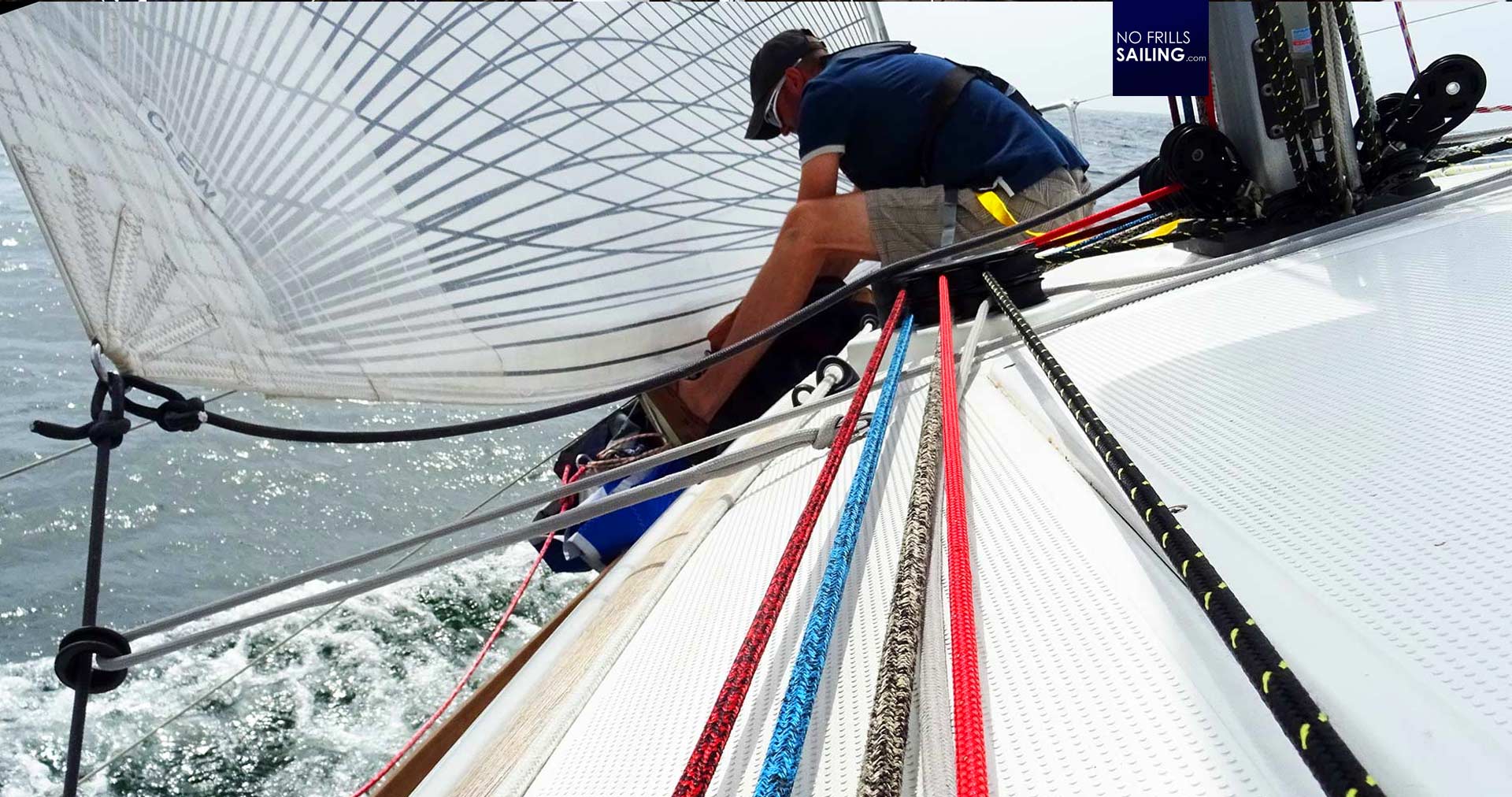
With my original project being cancelled the financing of the boat is cancelled too. Looking back to three years of working in the boating industry, accompanying some 25 customers in their journey of finding a new boat and acquiring it and hundreds of hundreds of intensive talks with potential clients about their new boats I would consider myself a kind of “insider” with a sufficient range of knowledge of that topic, including all my experiences with refitting my own King´s Cruiser 33 up to the point of finally selling the unfinished project now to go looking for a new boat. Over the past weeks my impression of this topic changed profoundly: As of now, I am more and more convinced that a small boat may be the ultimate solution and best way to go, when it comes to my new boat.
How I came to this idea
Well, during the last days I more and more come to the conclusion that the dream of a big boat or 40 to 44 feet although persisting may be remaining a dream forever. I am still sure that a boat of this size is perfect for long haul offshore passages and living aboard in many, many ways – yet more reasons speak against it of which money obviously is the biggest, yet not the only one. Let me tell you a story. It´s a gedankenexperiment. During the last days and weeks not being able to go out and sail due to the lockdown, I browsed my cruise reports here on this magazine and kind of read through my favourite sailing trips of the past years. I remembered so many countless great occasions and moments with dear friends. In this, I realized the following: When I retrieved memories of me and my crew sitting together down below in the salon or in the cockpit, having a beer or having dinner or something, it was a no-brainer to think of these moments.
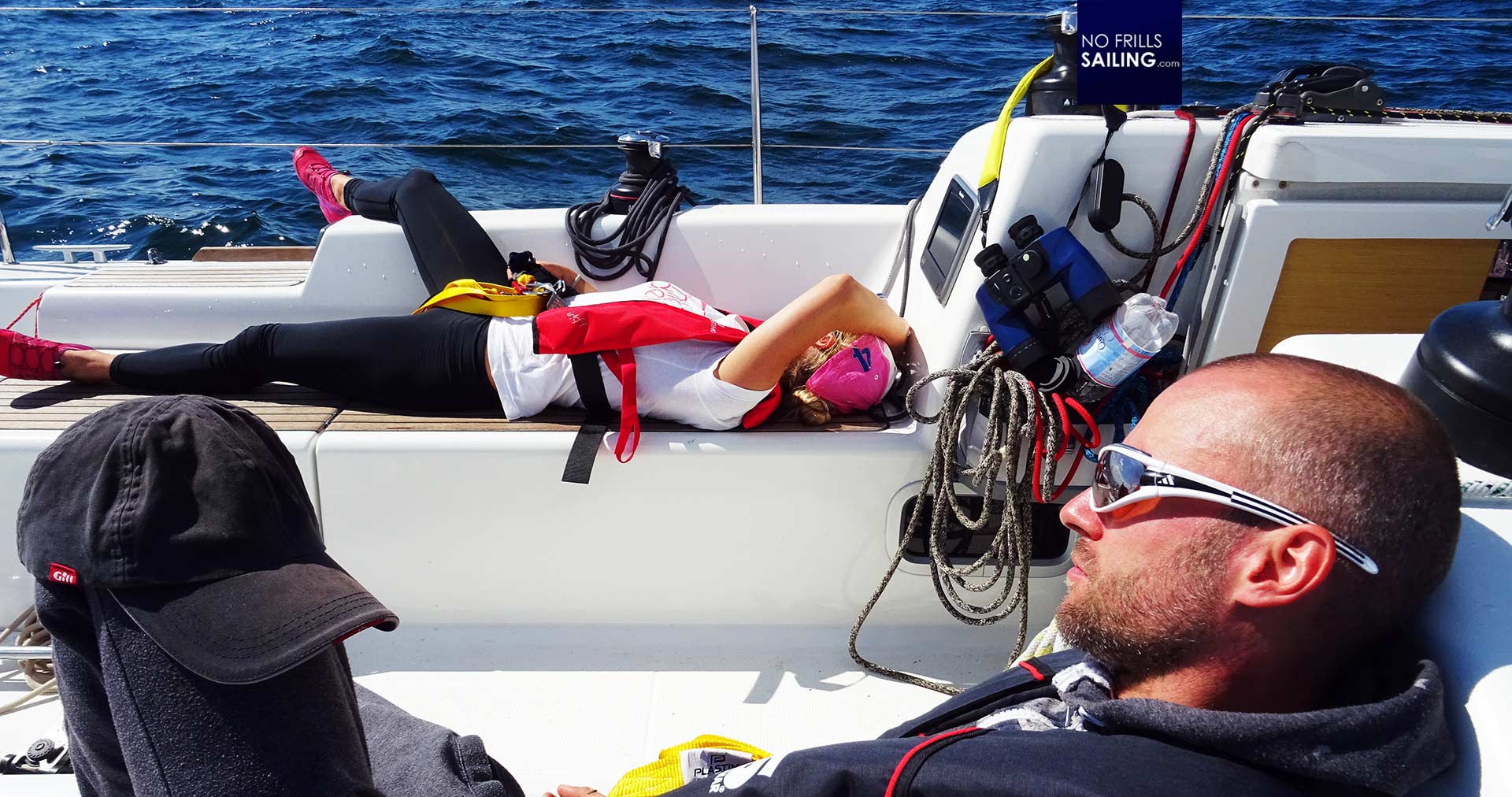
But I realized an interesting detail: In my memories, all the salons and an all the cockpits looked the same. In my memories, they felt the same. There was no memory of the actual size. In my mind, all salons looked the same. It was the moment, my brain saved, the laughter, the smiles, the good wine, the people. But never the size: No matter of which trip I´ve thought, be it an 48-footer or a small 30-footer, I don´t have specific memories of how the size of the salon felt other than knowing the fact which boat it was, in my mind they all lokked the same. Can it be that size does not matter? I suddenly realized that in my memories the size of the boat never played a role: It was the people, the weather, the waves, the wind. So here´s my idea: A small boat may be the solution. Let´s dive deeper into this …
5 Reasons for going for a small boat
Depending on what you fancy, you will always find reasons pro or against big or small boats. But thinking of it, I really find just one incontrovertible real hard fact and reason for a big boat that can never be claimed by a smaller yacht: Safety and stability of the platform. It is just a fact that the bigger the boat the less prone the hull is to foul weather and waves. It´s more comfortable motion-wise to sail thus making it safer. A small boat can never catch up to this for real. Other than that on the other side, the rest of the reasons speak in favor of a small yacht: Money in the first place, the simplicity of the yacht, the fact that you mostly sail alone or double handed on shorter trips, the fact that finding anchorage and berths is easier and of course the fun of sailing, of really feeling the wind.
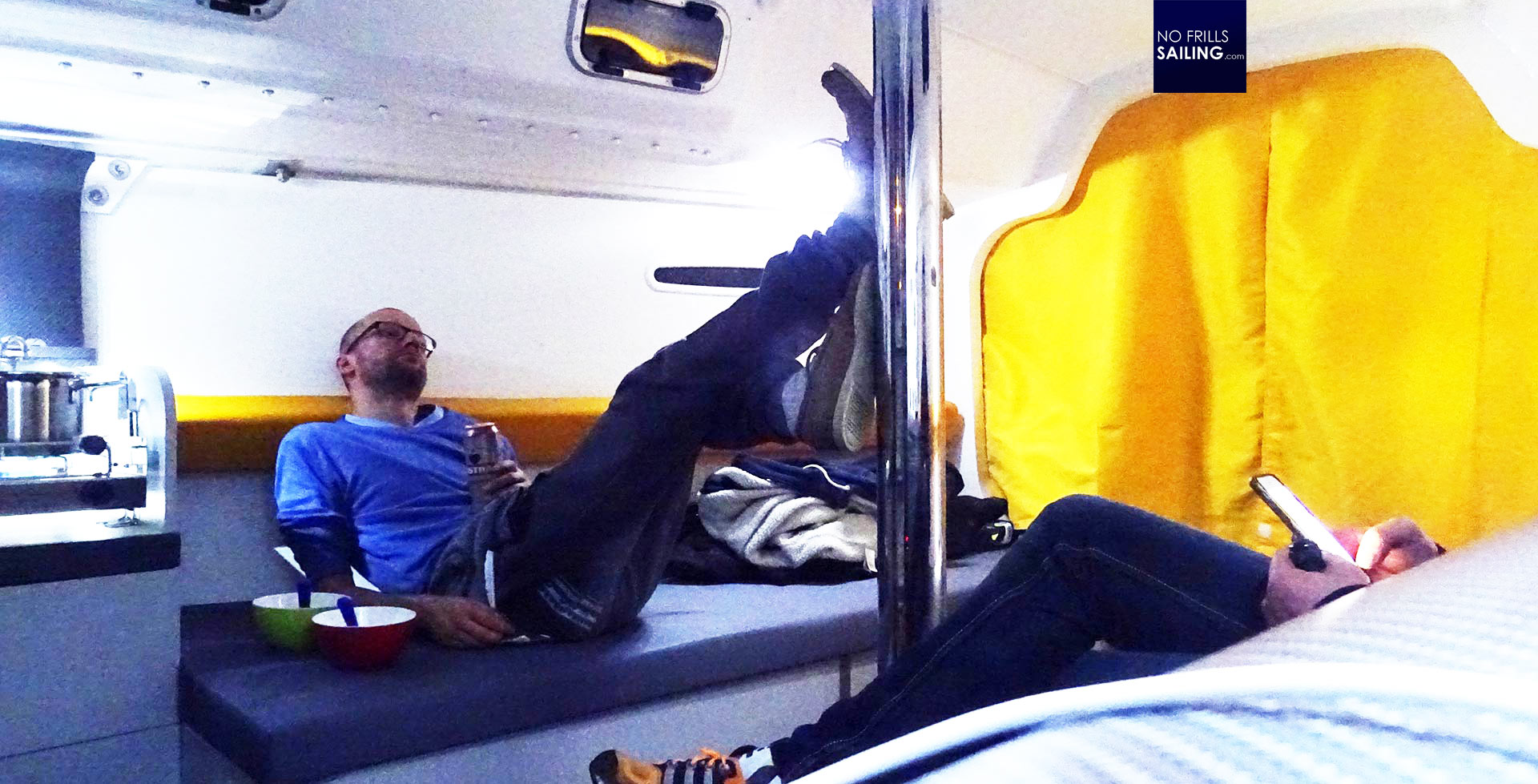
We break down each of these points in more detail soon. So, when we talk of a small boat project, the old question “new or used?” arises inevitably and me personally I have found the answer: Never again a used boat! I know that budgets are currently down and there are so many boats for sale but also: There is so many crap out there and you have to be very lucky in finding a good pre-owner who isn´t selling an old bucket which will make your hair turn grey soon. New boats are more expensive, of course, and quality may not be the same as it was 15 years ago, sure, but with a new boat you´ll get at least 2 years of warranty by your dealer and the yard. That´s 2 years time to perfect the yacht and stamp out all teething troubles. As long as it is no aluminium boat, I´ll go for a brand new one. Which one? Well, first things first …
Budget-wise: Small boats save money. A lot of it.
Let´s talk budgets first. Obviously, buying a smaller boat requires a smaller budget. That´s logical. It´s also obvious that if you do not invest all of you available money into the boat itself, you will save some budget for the actual sailing trips. Money can buy you time – precious sailing time! I´ve checked the big production boat company´s websites for the base prices of boats from 20 to 65 feet and put the data into a graph. Interesting to see that the rise of the graph shows indeed an exponential growth of the budget needed to buy a boat:

At the beginning costs rise steadily but fairly slowly. It´s the 40-feet boat that marks a first change as overall budget for a boat begins to increase exponentially, finally going through the roof with the 48/50-feet mark. That said and documented, you´ll see that in the small- and medium-sized boat market the increase of initial boat prices is not that steep, indicating that we do see a roughly coherent buyership, maybe the same type of buyers. People going bigger than 40 feet seem to have much more budget available and/or a bigger demand for more equipment, quality or other. Bigger that 50 feet means budgets starting at more than half a million Euros – meaning that we talk about a very well-off clientele. Surely: A small boat of around 30 feet will need a budget of some 120.000 to 130.000 Euros (including VAT, transport, rigging & commissioning), whereas a 40-footer will already see an increase of this budget to the 300.000 Euros-mark.
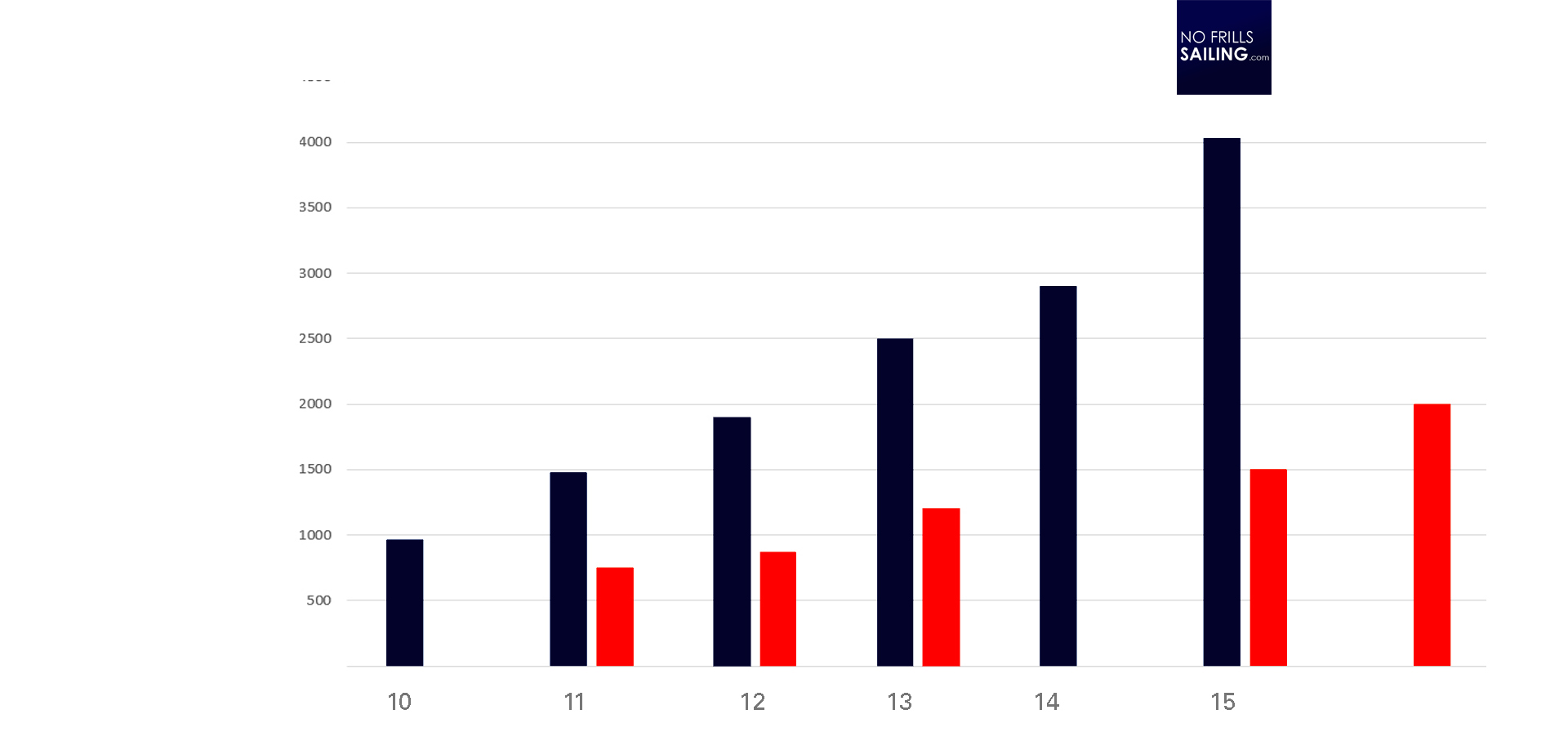
Another thing to take into consideration are the running costs. My experience in being a professional boat dealer is that most owners or buyers do not really calculate these costs. They know that a boat “costs something” but they never really calculate. They do care about the initial budget and think that somehow the running costs will be covered. Well, just take the berth. See the graph above (I´ve checked an average Baltic Sea marina, seasonal berths for boats vom 9 to 15 metres). I was, by the way, surprise that I at least for these marinas could not confirm an exponential growth of berth-prices increasing by the size of the boat, but the graph speaks for itself.
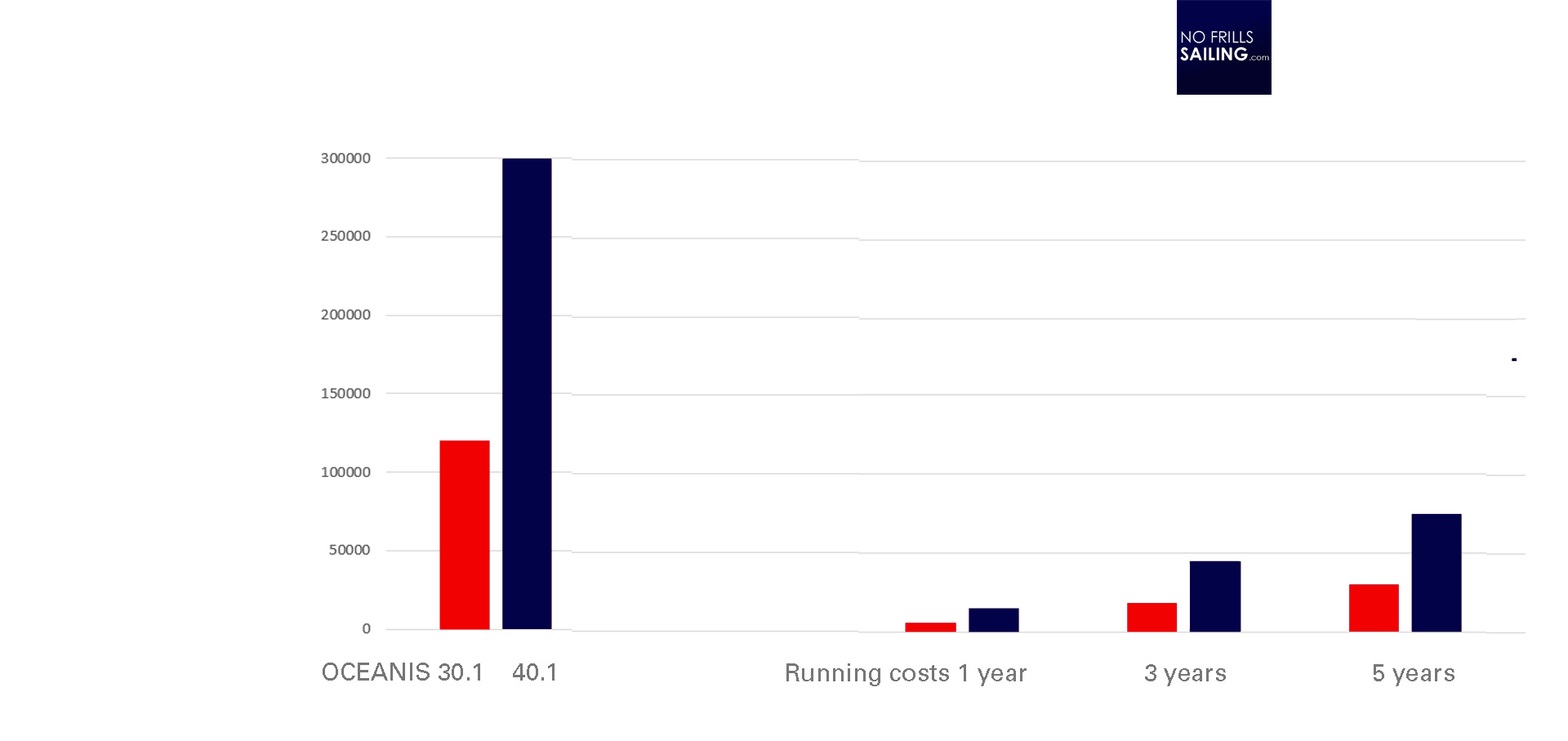
Roughly, for a sailboat, I would say that 5 per cent of the boat price should be assumed as annual budget for covering the running costs. That´s the berth, winter storage, insurance premiums, maintenance, antifouling and other, regular spendings needed. Now, let´s see what this means in real life. A 30-feet boat, like the Oceanis 30.1 versus a 40-feet Oceanis in the rough calculation over 3 and four years (graph above). See what I mean? The difference in money needed to just finance the bigger boat is over this time a staggering amount. Just think of what you could do with this budget! You could easily pay for weeks maybe months off work sailing or a set of really good sails … I think, just budget-wise, the decision to go for a smaller boat should be clear: 5 years running a 30-footer vs. 40-footer means saving running costs for another 5 years!
Small Boats = Easy Boats + Fun Sailing
Another aspect in favor of a small boat would be the easiness of maintaining and running the boat. Small boats mean comparatively small sails area that has to be controlled and thus no need for larger electronic equipment: An electric winch, which I would call absolutely indispensable on boats larger than 40 feet, cost around 1.000 Euros upwards. Manual winches roughly half the price. You don´t need large battery-capacity, no maintenance and you are less prone to failure. Thus saving cost again. But it´s not just the budgetary consideration – it´s the fun in sailing that points toward a smaller boat.
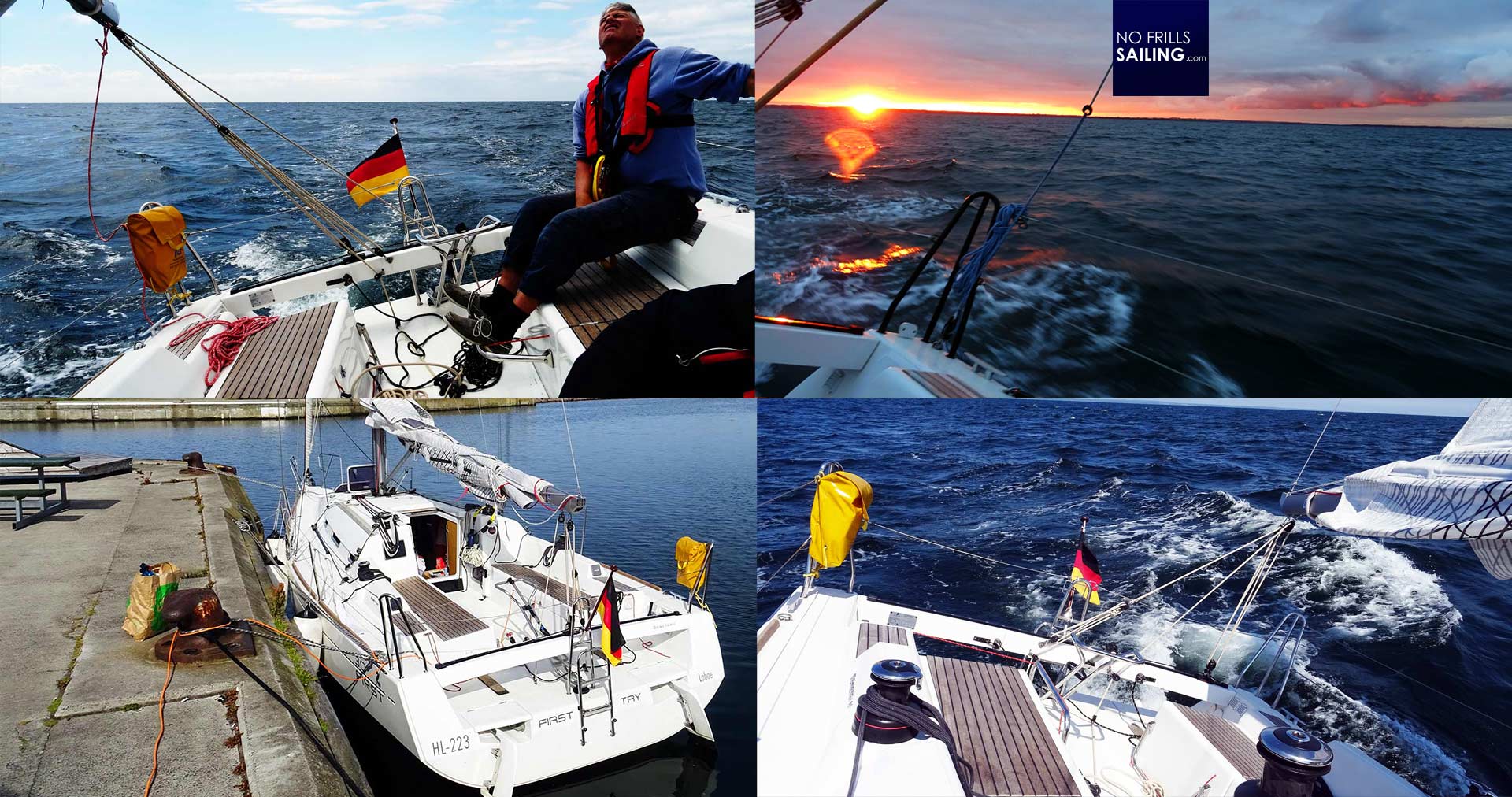
The larger something is the more energy is needed to get it up and running. Take the Gennaker for example. On a bigger boat the sail area of a Gennaker may be too big rendering it inoperable by one person alone – on the Oceanis 30.1 this light winds sail is easily manageable single handed. The whole feel of the boat, the wind playing with the sails, acceleration and sails trimming can be done more vividly, more intensively on a smaller boat: The “feel” for the ocean, the feel for nature is much more direct.
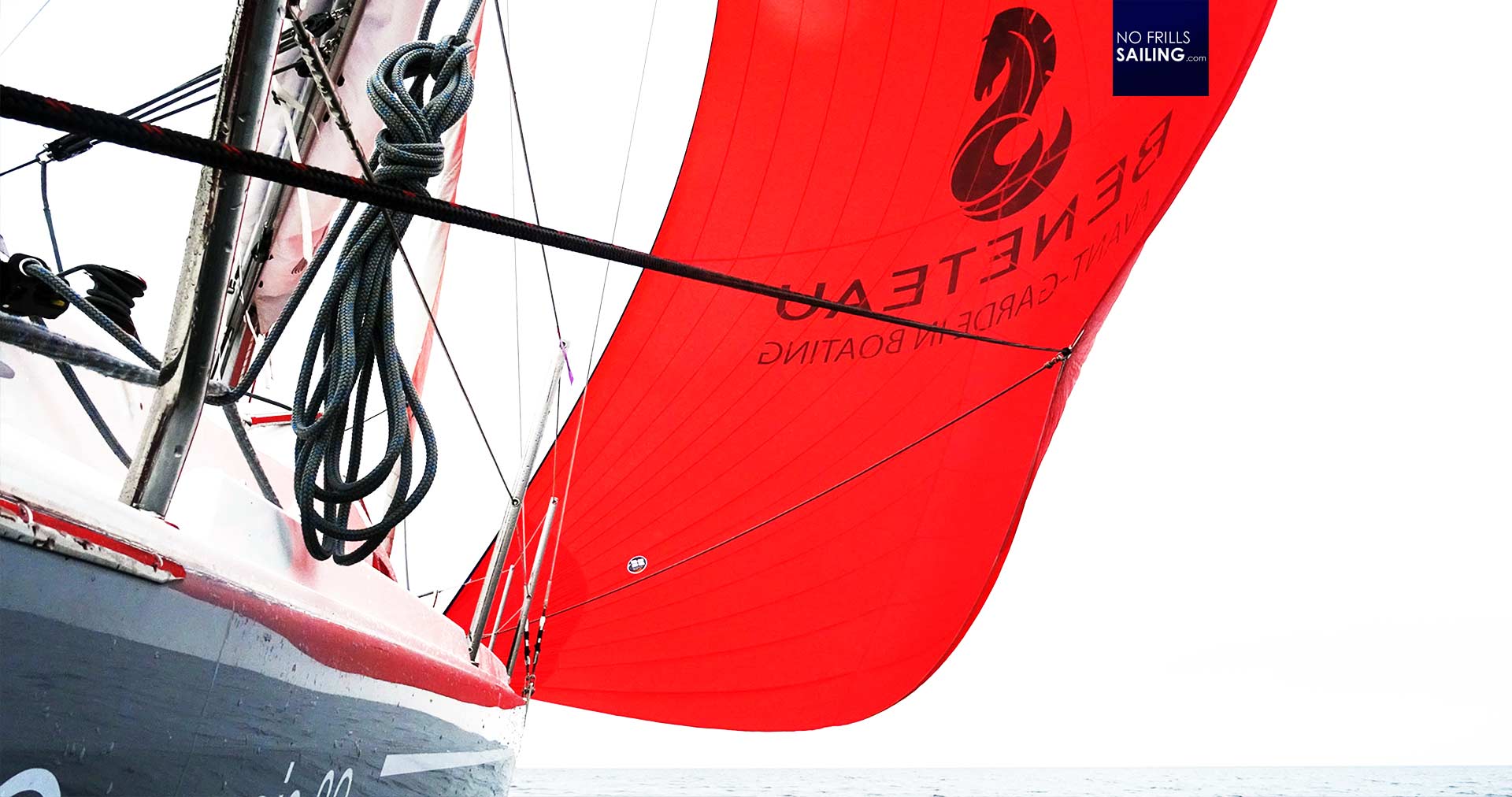
Which brings us to the steering “problem”. Lots of people I know don´t like tiller steering for some reason. I must admit, I am as well more a wheel-helmsman than on a tiller. It somehow feels cooler to stand behind the wheel and control the boat, for me it definitely adds a convenient feeling of safety especially when manoeuvering. On the other hand, tiller steering means direct control, faster steering commands and a sudden feedback from the rudder blades – a fine tuning in helming the boat is possible to a degree never provided by a wheel. Also, less moving parts mean a simpler steering which is easier to operate, to maintain and finally to repair.
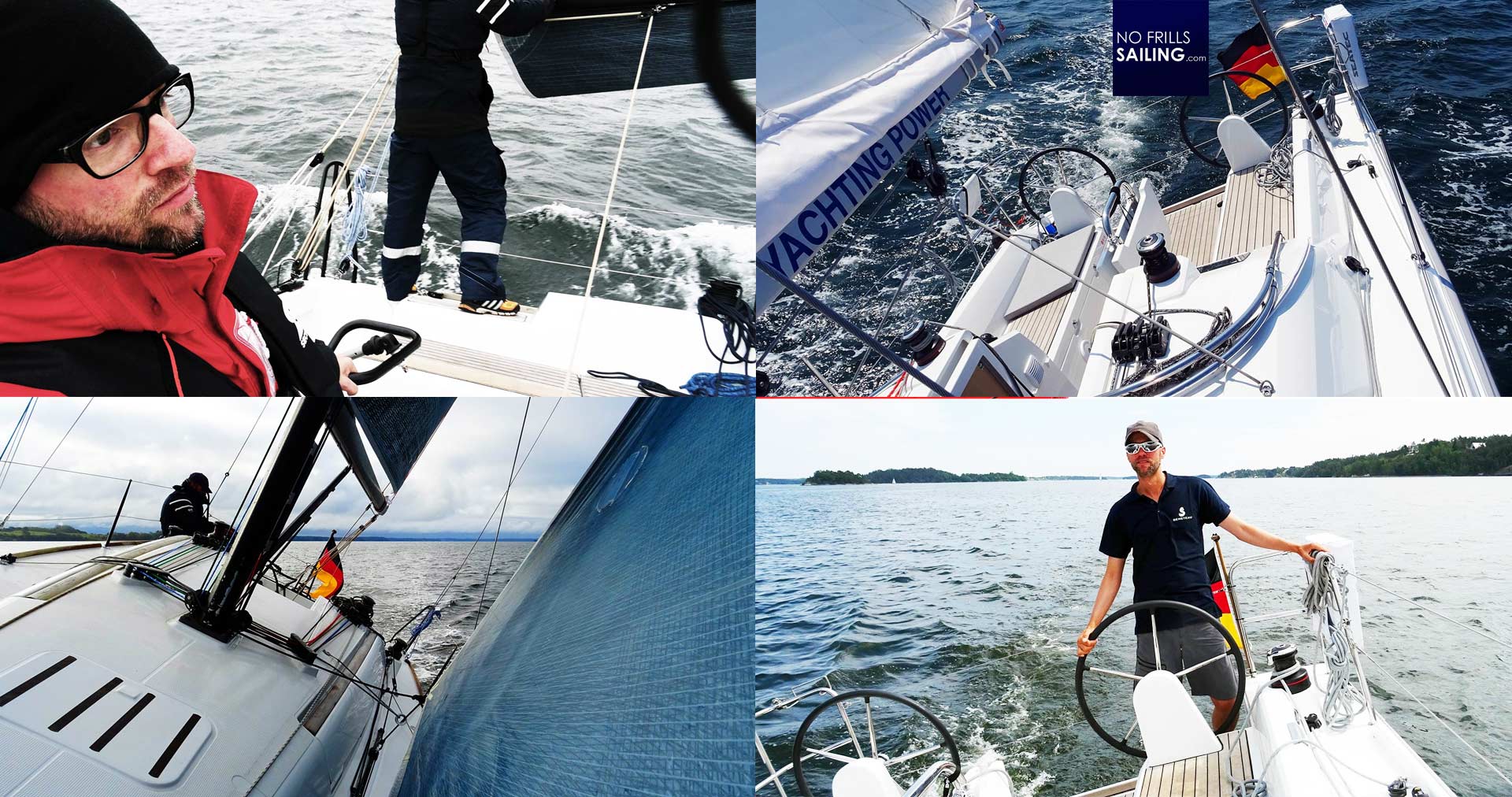
Looking at how I sail longer distances, I must say that 90 per cent of the time my helmsman is the auto pilot. So, no matter which kind of steering solution you prefer, you should always invest in a high-class and very capable auto-pilot system. There are a lot of boats in the market offering single or double wheel helming, most of the more “serious” smaller sailing yachts come with tiller steering for sure. In the end, all the time I sailed with tiller, I got used to it pretty fast and I don´t see why this should be a dealbreaker for a boat.
Sailing with a small crew: Who needs a big boat?
Hand on your heart: How do you sail most of the time? When I look at myself, I prefer the smallest possible crew size on a boat: Which is myself plus another one. Sailing with just one friend is in my view the most relaxed and most intense way of utilizing a boat. Even on longer trips, like my sailing trip to Sweden last year I chose to do it with just one single buddy. Everything is easier when you are just two: There is just one more opinion to consider, just one more to be considerate of, just one to count onto. I love it. Okay, sometimes a couple as guests will do as well, but more than three other persons is just too much of a psychological hustle for me. Mark my words here because I´ve experienced a real mutiny on one occasion and that was due to people not matching.
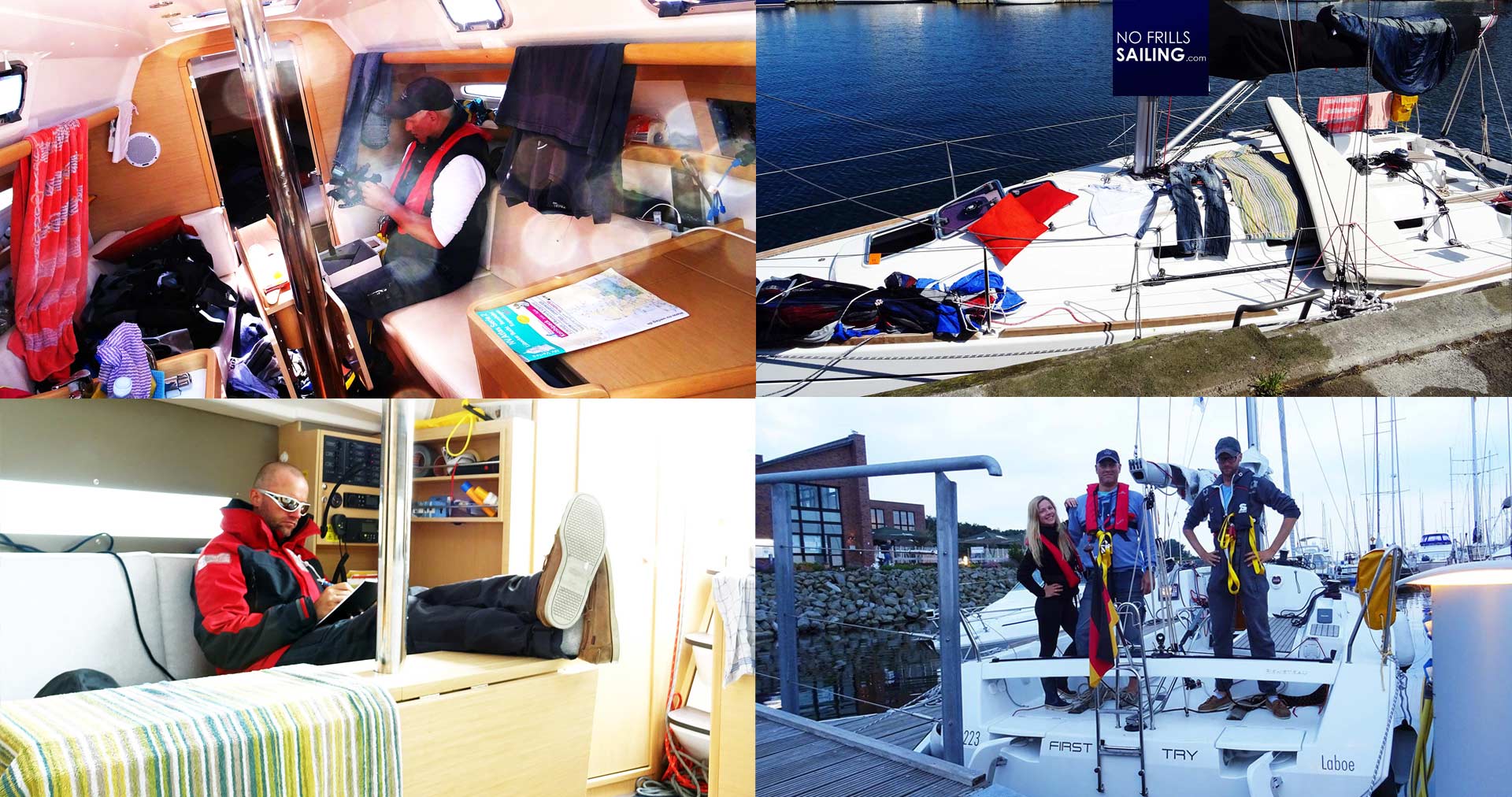
So, if you most of the time sail with a crew of two, where´s the need for a big boat? Sure, having the volume inside and the sailing-power at hand of a big boat is nice, but do you really need this to be happy? Another question: How often do you sail? When I look at my logbook I realized that I am able to pull off two bigger sailing trips of two weeks duration per year and the rest is just weekends or prolonged weekends from Friday to Monday. Meaning: Most of the time I am aboard for just one or two nights. Again: If this is the preferred usage of your boat, why spend so much money for a big yacht made to cross oceans for years when you will never do it anyway?
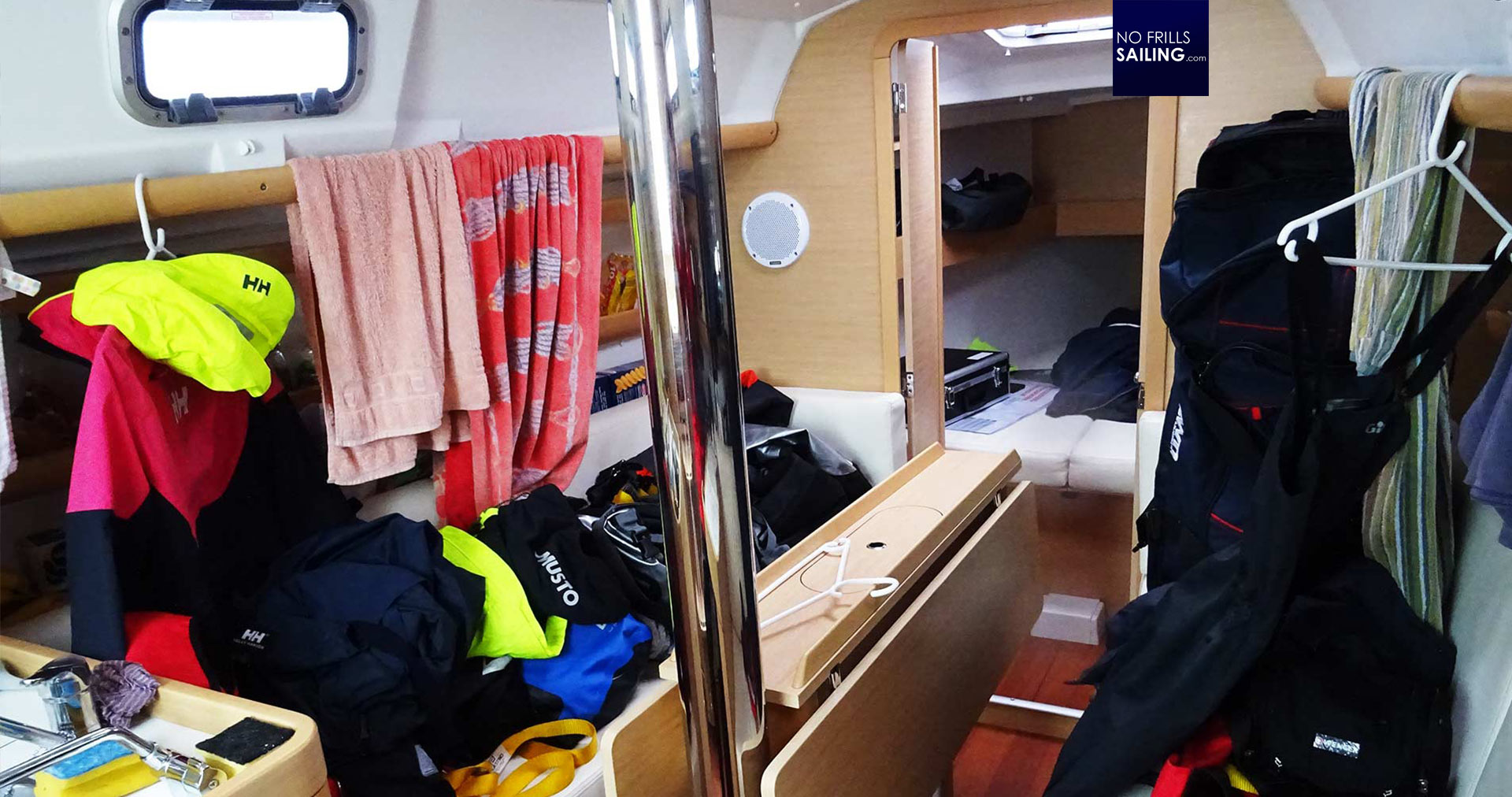
Sailing small is of course causing some trouble. First and foremost is how to utilize the small amount of stowage – and the decisions made at home what to take with you and what to leave. Also, even with two people living on such a confined space can be terrifying, drying your clothing, finding some privacy or behaving the right way in times of conflict. On the other hand, living and “working” together so cramped will push the need for cooperation, for tolerance and for honest communication. I always found it very delighting and enlightening sailing on small boats.
Sneaking up to a good anchorage
A practical consideration when underway: Small boats don´t have problems finding berths and anchorages. Due to the smaller size and the smaller draft of the keels you can sneek up the smalles bays or inlets with ease to enjoy the quietness of a lonely, untouched anchorage. I´ve tested it and I not only loved it – it really opened my eyes! The amount of possibilities quadruples when sizing down your boat and thus making you more independent from shore-based infrastructure, opening up whole new possibilities to discover the area you are visiting.
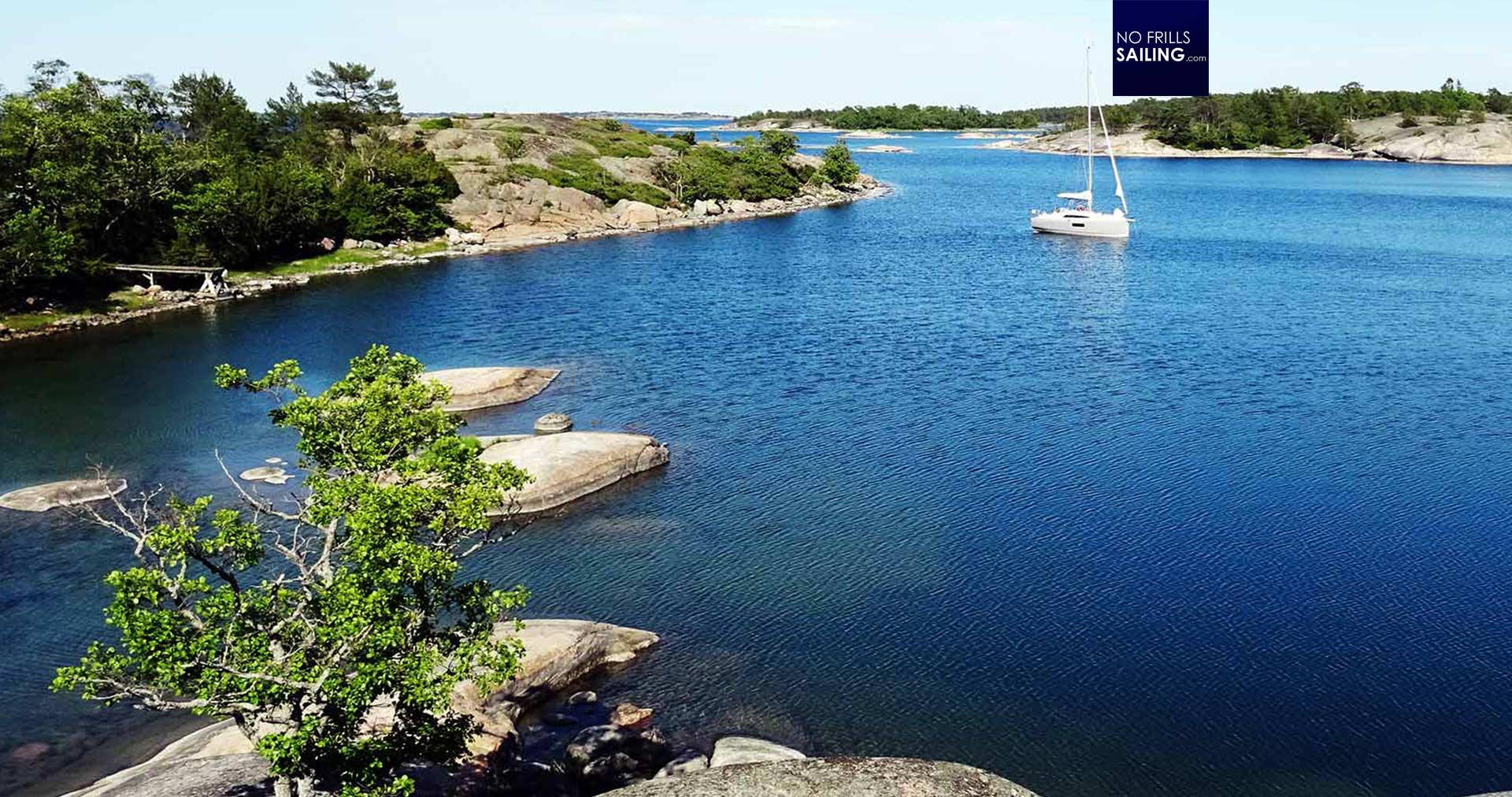
Also, when it comes to sailing in the high season: No need to rush! At least in the Baltic Sea, but also for large portions of the Mediterranean Sea the bigger the boat the less berths are available. That means you will are either forced to reserve a berth in advance, making your sailing trips less and less spontaneous or you will have to rush to be first in the marina to catch a precious mooring. Not so with a small boat: There´s almost always a berth available for a small boat.
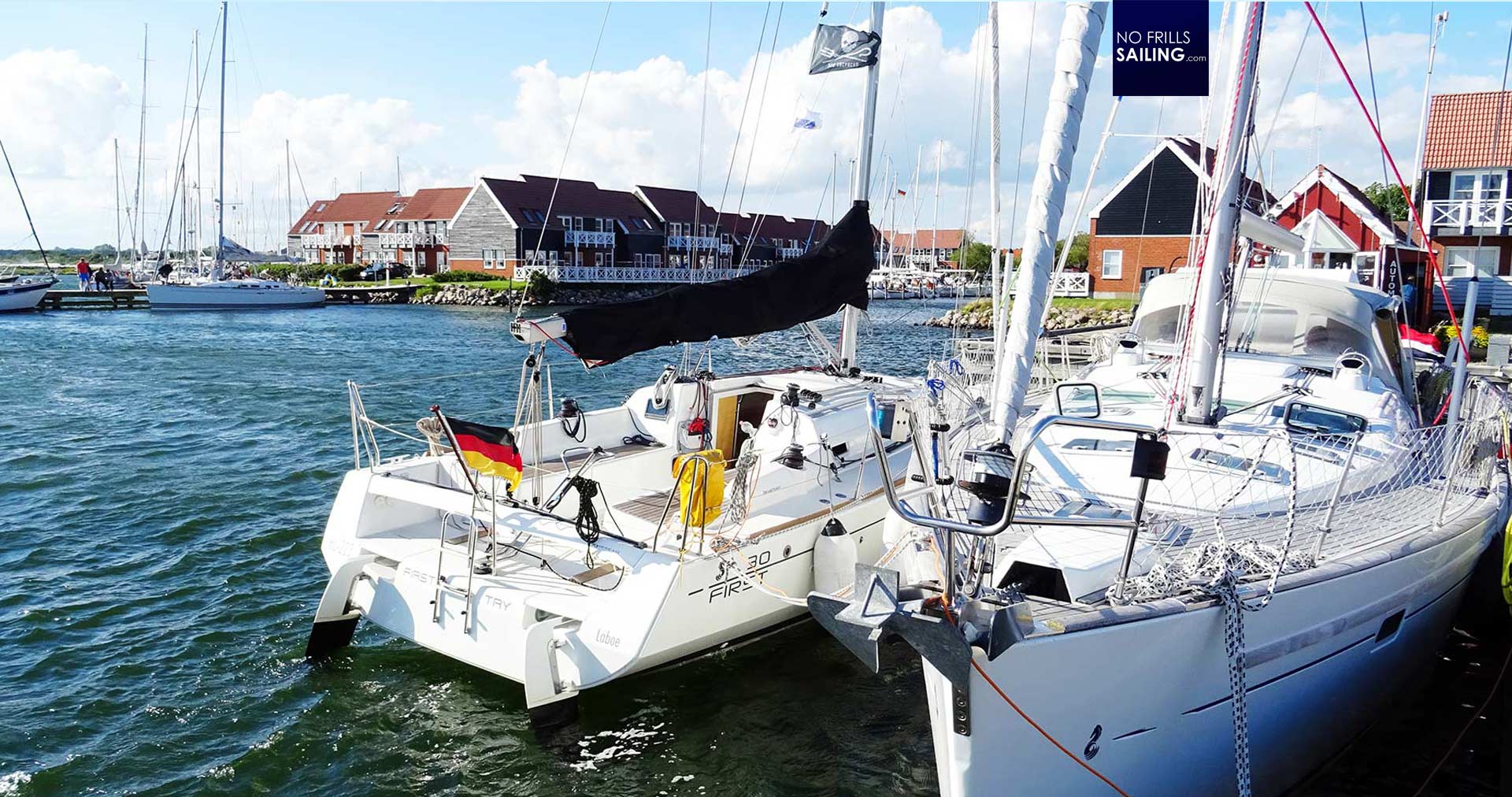
The more I think about small boats the more points I find speaking in favor of downsizing my desire for a new boat. In doing so, I am not just making a purchase in the near future more likely to happen sooner than later, I am also sure to bringing back much more sailing fun to my beloved hobby. Less caring, less thinking, less worrying – “more sailing”, that is the motto! And I am really on fire now, the more I think about it. But here comes the tough question: Of all these nice boats out there, which one can it be? Which suits me and my needs the best?
Which boat to go for?
On boy, and how many great boats are there available, ranging from cruising-capable pocket-sized yachts offered by the big brand names to the more individual, performance-oriented boats by smaller companies. So, the first question would be cruising or performance? Well, for me, to be honest, it´s always more performance than cruising. I love outdoor-trips with a simple tent, a one-flamed stove and basic food. I love it, because it brings me down from my “civilized” and over-complicated life, it helps me to re-focus on what really matters and enjoy nature, weather, wind, water – even rain – in the purest possible way. So in essence: I really don´t need much comfort.
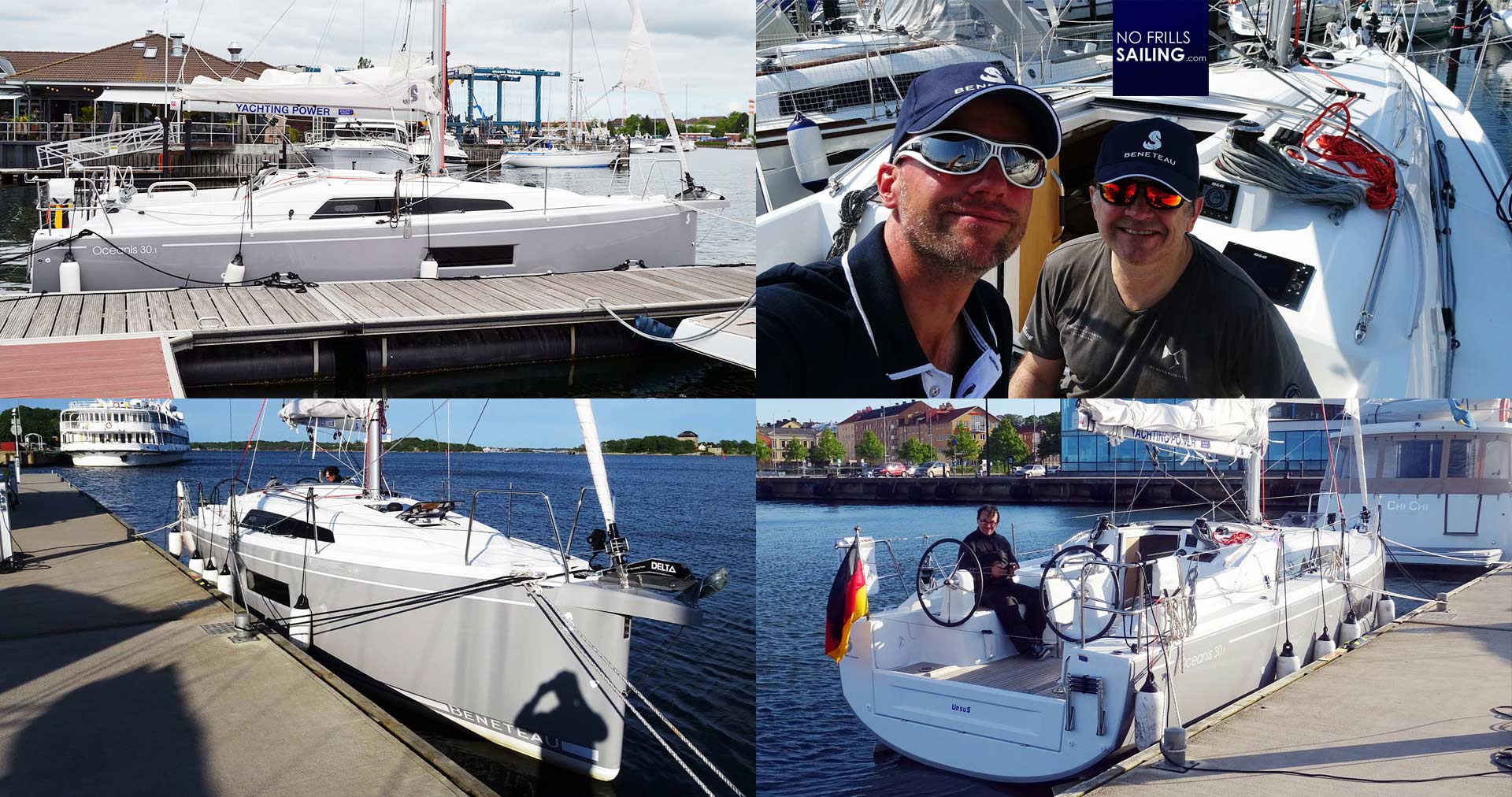
On the other hand: Having at least some hot water, a decent WC to take a dump, a reasonably sized berth for a good night sleep, a dinner table to sit around and enjoy the food or a good wine cannot be abstained from. I just love the approach by Beneteau on the Oceanis 30.1 – it´s a really neat boat, offering lots of comfort. She is a very twinkle-toed boat, very responsive (even with twin wheel-configuration) and quickly sailing, especially under Gennaker. Her price is awesome, a fully-speced Oceanis 30.1 including transport, commissioning and rigging can is around 100.000 Euros ex VAT. But still, as much as I love her, she is not a real performer in a way, comfort is over performance here, so let´s look at some other candidates.
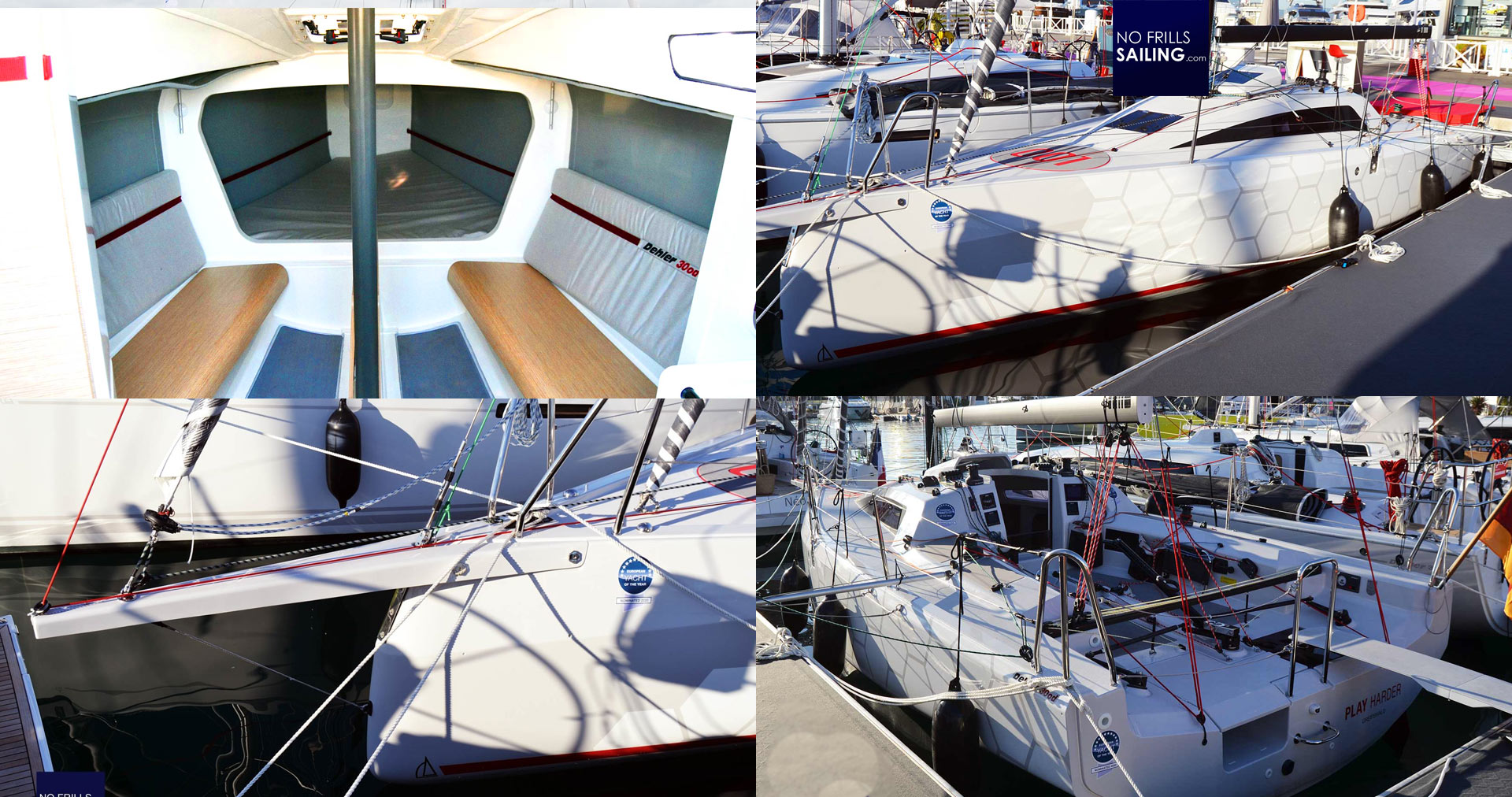
Like this one, the Dehler 30 One Design, which is a very, very interesting boat. I´ve seen the prototype in Cannes this year and I was impressed by the degree of armament this “sailing weapon” got from the yard. The finishing quality was very promising and all people I spoke to about that boat since then have shared my impression. I am working on getting some miles of sailing on this boat in a sea trial and when Corona-restrictions are lowered that will be among the first boats I´ll board for sure.
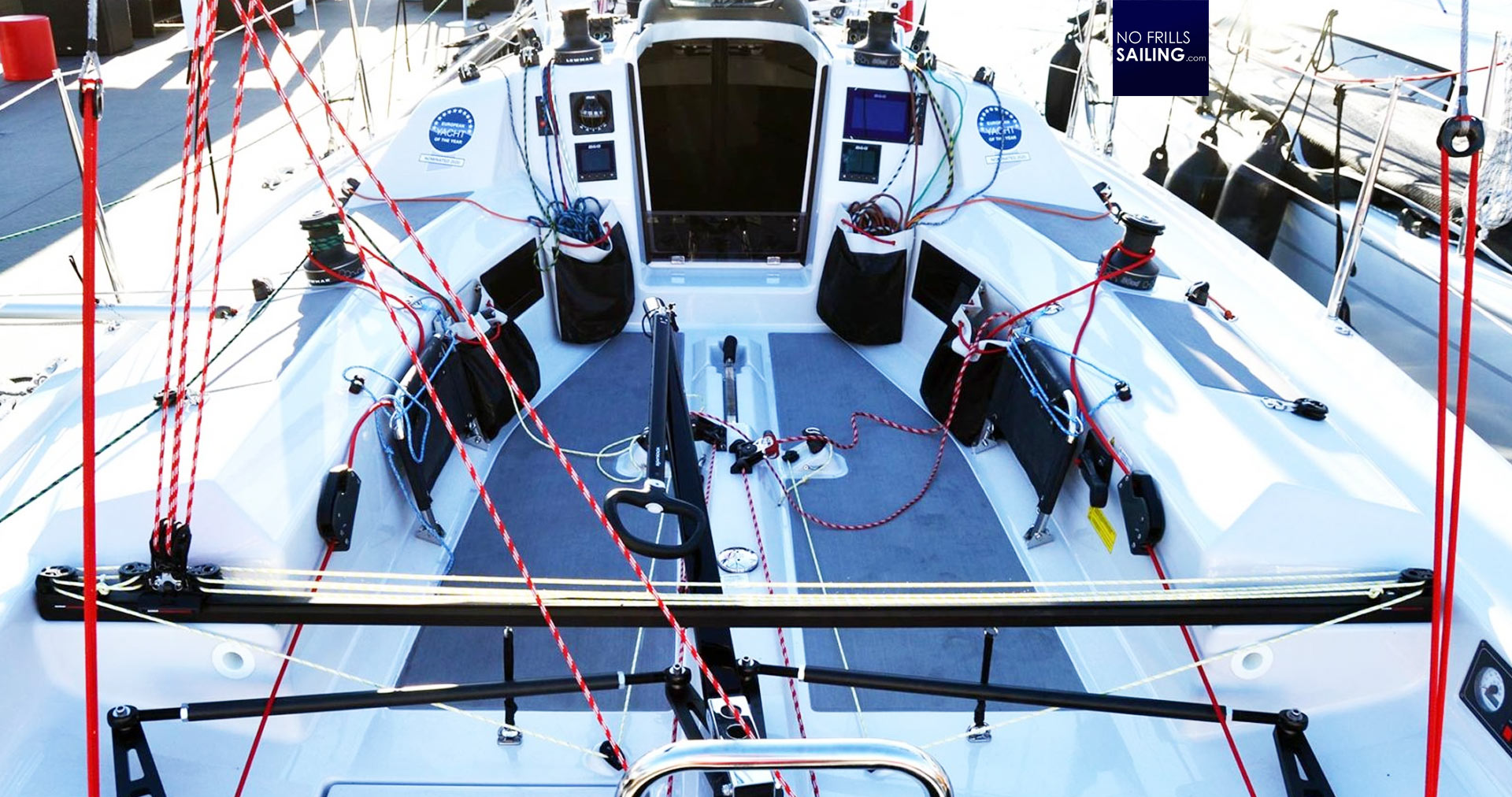
Unlike other boats of this kind, like the J-112e (bigger, more cruising-capable), the Pogo 30 or 36, the RM 9.70 (though with insolvency of the yard and takeover by Grande Lange Yachting it´s not clear what will happen to the brand) or the much admired JPK the Dehler seems to be affordable too: Base price for the boat would come out as around 120.000 Euros ex VAT, although a fully race-optimized 30OD can clock as much as 180.000 Euros ex VAT. Nevertheless, that´s nothing near the much bigger budgets needed for the mentioned names.
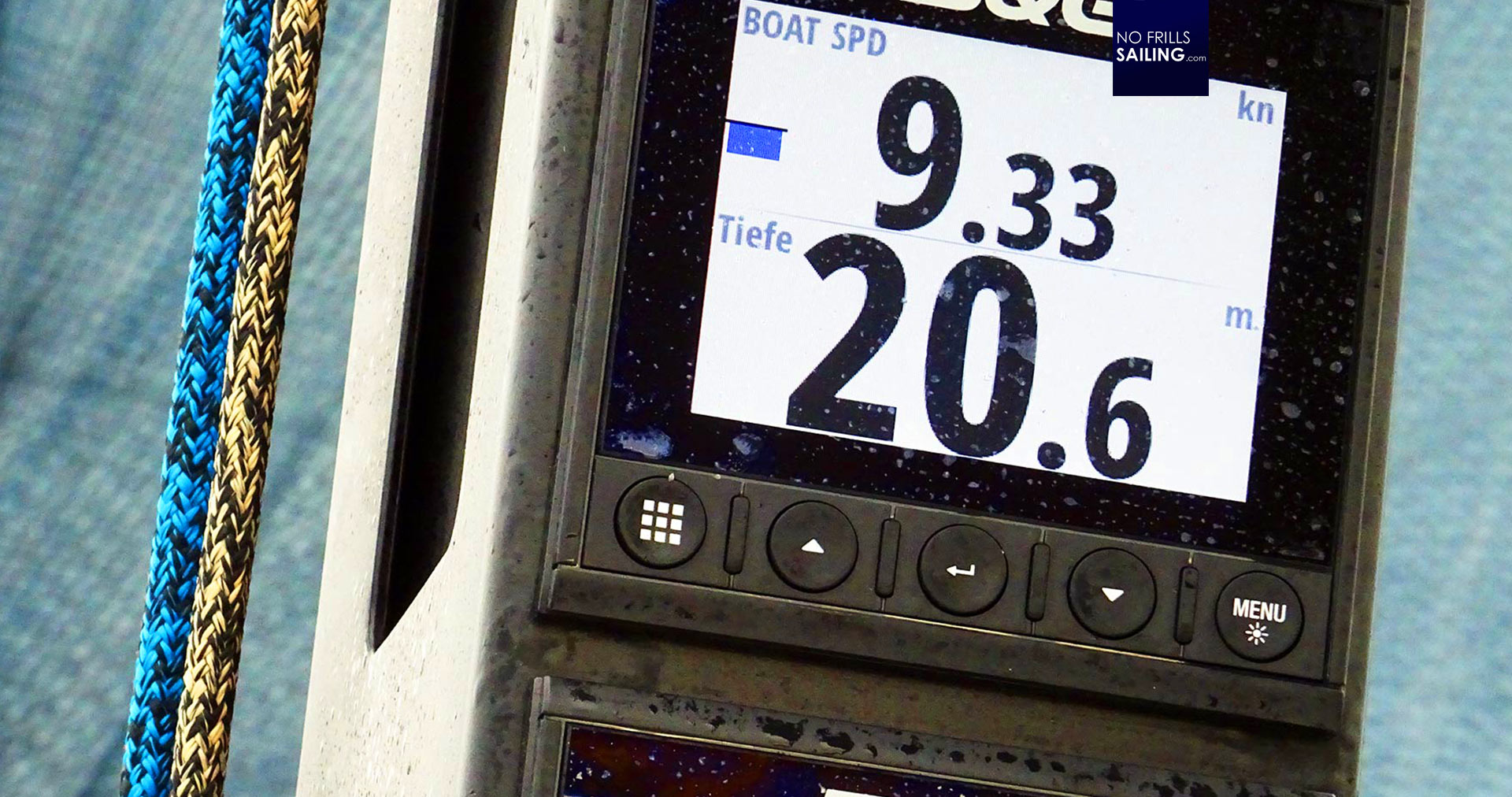
I like the Dehler´s approach: She is a seemingly fast boat built for single and double hand races especially in the Baltic Sea. I am sure the boat will behave just fine as she is certified CE Category A (4 Persons) on all other offshore-regions, as well as Transat. Inside she offers the least compromise of having comfort, I love the approach of utilizing new materials, taking away all unnecessary equipment and false front, leaving just the essential and reducing this to a minimum. She´s like a space capsule and I am sure I could fit here just fine. Much more than in her counterpart from France, the first production-grade foiling boat, the Figaro 3.
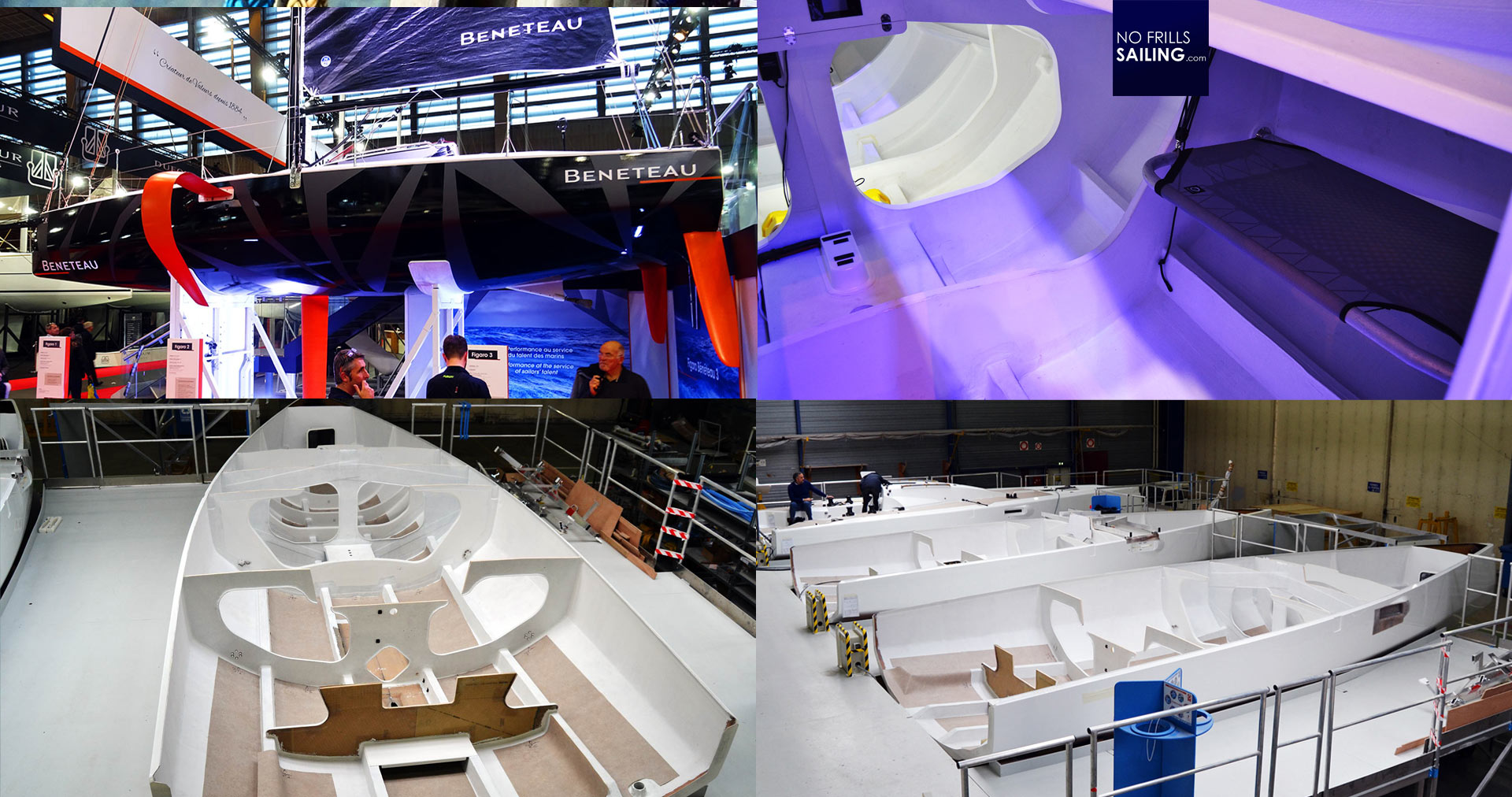
I´ve visited this yacht multiple times in France and spoke to her masterminds, Gianguido Girotti, Luc Joessell and others. She is a fascinating yacht and by the way much less complicated that people think, but in no way the right boat for me: The Figaro 3 is a pure thoroughbred sports-utility and there´s no way in converting her to be cruising-ready, at least not without an excessive invest. There are so many interesting small boats buts considering my limited financial capabilities and the kind of sailing I want to practice, honestly, right now the two boats are on top of my list. As I have plenty of sailing experience with the Oceanis 30.1 I hope to gain some on the 30OD too.
What to do next?
Regardless of what happens to me and in which direction I will go with my next boat, I find it highly interesting to play around with these kind of thoughts. Turning my own experience of sailing boats of various sizes and knowledge I gain through reading or talking with others into facts which help me find my own way. Of course, my heart does still beat and will always be beating for aluminium yachts, especially the big and small Berckemeyer-boats which I absolutely adore. But since I do not gamble nor speculate at the stock exchange the budget needed for these fine boats will never be available for me. But that´s perfectly normal, happening to 99 per cent of all boat owners. So I am looking into finding the best alternatives fitting both my needs and my purse. Beneteau´s Oceanis 30.1 and Dehler´s 30OD may be the right boats.
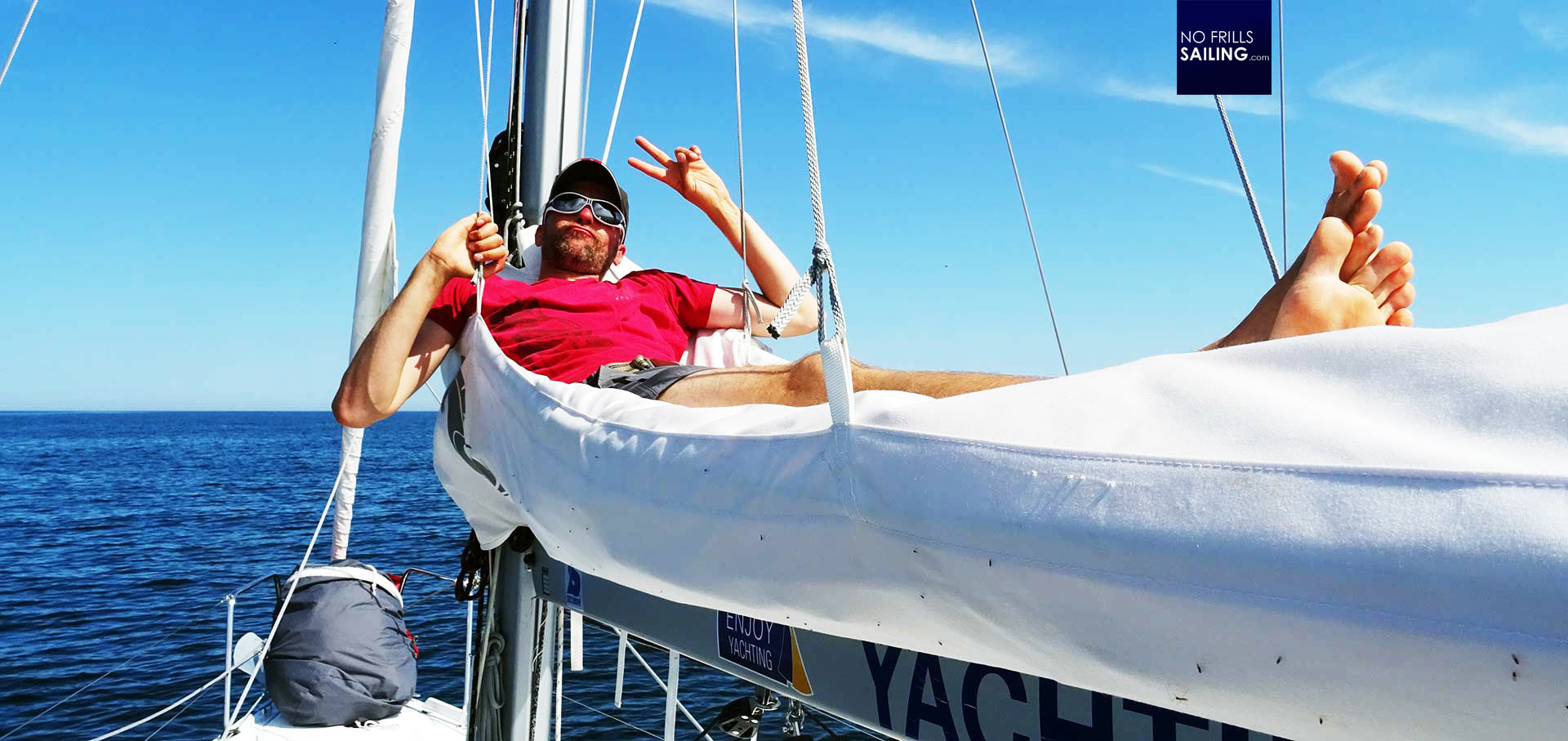
Or something completely different? There are still some rumors surrounding a First 35/36, which considering the success and beauty of the First 24/27 would be a great, great boat to look at (and would me buying a Beneteau would “keep me in the family” of course). I also have the feeling that one possible outcome of the Covid-19-crisis could be a return to more smaller boats of the companies since a recession can inevitably mean smaller budgets client-wise thus more demand for smaller boats. These are exciting times – I am happy you accompany me in my illustrious voyage to finding a new boat. Feel free to comment any time, dear readers.
You may also be interested to reading these articles:
Financing a dream yacht
Black hole yacht refit?
Sleek & fast on 35 feet: Archambault A35 review
